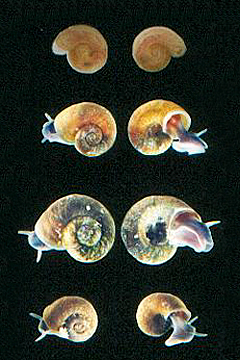Gastropoda, general view on the systematic:
Planorbidae Rafinesque, 1815:
Representatives of Planorbidae (superfamily: Planorbioidea, Order: Basommatophora, subclass: Pulmonata) are found not only in bays (four palaearctic species of the genera Bathyomphalus and Gyraulus) but also in open Baikal and River Angara (subendemic genus Choanomphalus). According to the systematic position of Choanomphalus a close relation to Gyraulus but also to Planorbis was dicussed (Meier Brook, 1983). In other ancient lakes (Lake Ohrid in Yugoslavia and Lake Biwa in Japan) planorbid species were discribed, characterized by a hyperstroph definitive shell as in Choanomphalus (Preston, 1916).

From above: Choanomphalus planorbiformis, Ch. amauronius, Ch. maacki, Ch. angulatus
In their anatomy they clearly differ from Choanomphalus
and therefore were regarded as belonging to Gyraulus. It is under
question, whether or not the hyperstrophe shell is a homologous character.
Some species of Choanomphalus exhibits convergency in
cochological characters to valvatids even in the fine structure of the protoconch,
but the number of protoconch whorls gives the paleontologist a clear differenciation
character.
In regard to the number of species there are different
opinions:
The brothers W. and B. Dybowski (1925) and Lindholm (1909)
described 16 species paralelly. Some of them where held as synonyms and Kozhov
(1936) regarded some of the morphes as intraspecific variations and reduced
the number of species to 8. Bekman & Starobogatov (1975) described
5 new species. Recently 22 species are given in the system of Starobogatov
& Sitnikova (1998), 17 of which and Ch. mongolicus from Lake Khubsugul
could be integrated into our investigations.